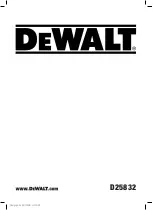
408-35143
Rev A
6
of 7
4.
CRIMP HEIGHT ADJUSTMENT
The tool frame features a ratchet mechanism and adjustment wheel with a range of settings. The ratchet
mechanism ensures that the tool has completed the cycle. The adjustment wheel controls the amount of handle
pressure exerted on the jaws and dies during the crimping procedure. The ratchet is preset prior to shipment,
but the crimp height must be verified.
Use and wear can also cause the tool to go out of adjustment. Quality control personnel should inspect and
adjust the crimp height on a regular basis.
NOTE
This is a general explanation of the adjustment. For specific information, refer to the instruction sheet packaged with the die
assembly.
1. Crimp a connector onto a properly-prepared wire of correct size.
2. Adjust the crimp height as needed.
If the crimp height is greater than recommended, remove the ratchet wheel adjustment screw and
rotate the adjustment wheel
counter-clockwise
to a higher setting. Repeat as required.
If the crimp height is less than recommended, remove the ratchet wheel adjustment screw and
rotate the adjustment wheel
clockwise
to a lower setting.
3. Repeat as required.
If the crimp cannot be made to conform to the dimensions provided in the applicable product application
specification, the tool or dies are defective and must be replaced.
5.
MAINTENANCE AND INSPECTION
5.1.
Initial inspection
The hand crimping tool frame assembly is inspected prior to shipment. Inspect it on arrival to ensure that it has
not been damaged during shipping.
5.2.
Daily maintenance
Operators of the tool must be made aware of, and responsible for, the following daily maintenance
requirements:
Remove dust, moisture, and any other contaminants from the tool with a clean, soft brush, or a clean,
soft, lint-free cloth. Do
not
use hard or abrasive objects that could damage the tool.
Make certain that the pivot pins are in place and secured with retaining rings.
Protect all pins, pivot points, and bearing surfaces with a thin coat of any good SAE 20 motor oil. Do
not oil excessively.
When the tool is not in use, keep the handles closed to prevent objects from becoming lodged in the
jaws.
Store the tool in a clean, dry area.

























